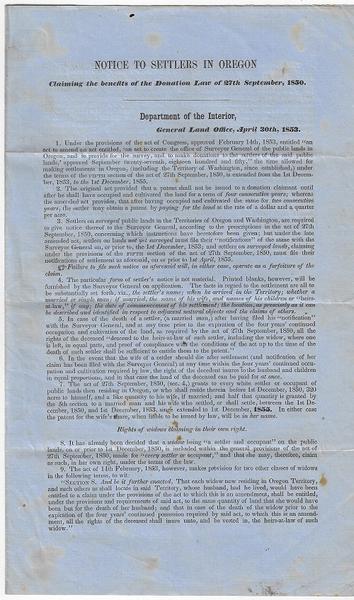SCARCE OREGON TERRITORY LAND PROMOTION – THE DONATION LAW OF 27TH SEPTEMBER 1850

SCARCE OREGON TERRITORY LAND PROMOTION – THE DONATION LAW OF 27TH SEPTEMBER 1850
NOTICE TO SETTLERS IN OREGON: CLAIMING THE BENEFITS OF THE DONATION LAW OF 27TH SEPTEMBER, 1850 Department of the Interior, General Land Office,
April 30, 1853. Washington, D.C.
First edition of this exceedingly scarce original territorial Donation Land Claim Act which updated the 1850 Donation Laws, was mailed upon request to early Oregon & Washington Territory settlers from local territorial land field offices, and also offered a powerful incentive to settlement of the Pacific Northwest. After the Oregon Territory had been formed on August 14, 1848, all original land grants recognized under the provisional government had been nullified, primarily disposing of the claims of British subjects inter-mixed in with Euro- American settlers. The original 1850 Act as distributed by the General Land Office field offices in the Oregon Territory (1850), and Washington Territory (1853) offered 320 acres at no charge to qualifying “White” adult U.S. citizens (640 acres to married couples), and although the 1853 amendment continued the program, it cut the size of allowable claims by half.
Members of Pacific Northwest Native American tribes were not recognized as U.S. citizens, and therefore could not own land under the law, although Section 4 allowed “American half-breed Indians” of legal age to take Donation claims. In addition, recipients of the land claims agreed to live on, and cultivate the allotment for four consecutive years, which could be counted retroactively, and afterwards a certificate would be issued granting immediate ownership once the land was considered occupied. This 1853 Donation Law claim amendment extended the Act through Dec. 1, 1855, directed the settlers to use appointed land surveyors,
although an ongoing issue was the excessive fees charged by local territorial land surveyors, as the practice became something of a racket, leading eventually to the dismissal of the first surveyor- general.
Travel over the Oregon Trail was grueling, with a high rate of attrition to aspiring settlers. Two key passages related to women making the trek with their families, were amended to the original Act in this 1853 notice which forced locals to recognize the legal rights of widows, with the first specifying “That each widow now residing in Oregon Territory and such others as shall locate in said Territory, whose husband, had he lived, would have been entitled to a claim under the provisions of the act to which this is an amendment, shall be entitled. . . to the same quantity of land that she would have been, but for the death of her husband. . .” even if
the husband died before the completion of the four years of occupation. In addition, Section 9 of this amendment also made specific provisions allowing women who were widows to claim the lands of husbands who died on the Oregon Trail, or on other routes to the Oregon Territory, as well as able after two years with filing to ensure that her heirs were allowed to inherit the property. Another key aspect for women of this Donation Law amendment was the
inclusion specifying that the “patent for the wife’s share, when liable to be issued by law, will be in her name.”
Even though Oregon & Washington Territories were explicitly anti-slavery, the Donation Land Law specifically excluded African-Americans, and Hawaiians, validated most of the Euro-American claims in the Willamette Valley, and attracted a land rush of Euro-American “White” settlers into the Umpqua and Rogue River valleys devastating driving continued conflicts between the two forces and engendering something akin to a race War in 1852 and
1853 with “White” volunteer militias soldiers forcibly removing Native Americans, later removed by U.S. Army troops to a newly created Coast Reservation. By the time that the law eventually expired in 1855, approximately 30,000 Euro-American “White” immigrants had entered the Oregon Territory, with some 7000 of them making claims on 2.5 million acres of land, overwhelmingly West of the Cascades. Oregon’s “recognized” citizen population rose from 11,800 in 1850 to over 60,000 by 1860.
Jacob Kamm (1823-1912) was recruited to the Oregon Territory in Dec., 1850 after the passage of the initial Donation Land Law to aid Lot Whitcomb in finishing his steamship “The Lot Whitcomb.” Kamm then joined with John Ainsworth, Abernathy, and Clark, all
merchants from Oregon City in 1854 to build the “Jenny Clark” the first sternwheel-driven steamboat to operate on the Rivers of the Pacific Northwest, launched Feb., 1855.
Although we could find no extant surviving original copy in public, or private holdings, and no auction records, one “Photostat Copy,” is held by the Univ. of Oregon - OCLC 814061817; Not listed in George Belknap’s Oregon Imprints, or in his list of “Lost Imprints” at rear. Although the typography appears quite similar to that of Asahel Bush’s “Laws of Oregon,” “Journal of the Council,” and “Report of the Commissioners” which were all printed in 1853; Kamm could very well have secured this “Land Office” promotion with no printer’s imprint from the local settlers offices in places he regularly worked as engineer and river pilot prior to his being recruited to the Oregon Territory, such as Sacramento, San Francisco, or St. Louis.
From the library of Caroline Augusta Gray Kamm (1840-1932), noted socialite and philanthropist in Portland, built home for poor women & girls with the YWCA, and was daughter of PNW pioneer William H. Gray (1810-1889) who traveled to the Lapwai Mission
in Lewiston, ID in 1836 where he was the Nez Perce secular agent, and she subsequently later married Jacob Kamm (1823-1912), pioneering Oregon steamship builder, industrialist, entrepreneur, and owner/operator of the Vancouver Transportation Co.
Reference: Poore, Descriptive Catalogue of Government Publications, p. 628; Nancy Cott, Domestic Relations and Law (1992), p. 322.
Folio. 8 x 13 in., 4 pgs. unpaginated. Expected very minor wear, overall in vg cond.
